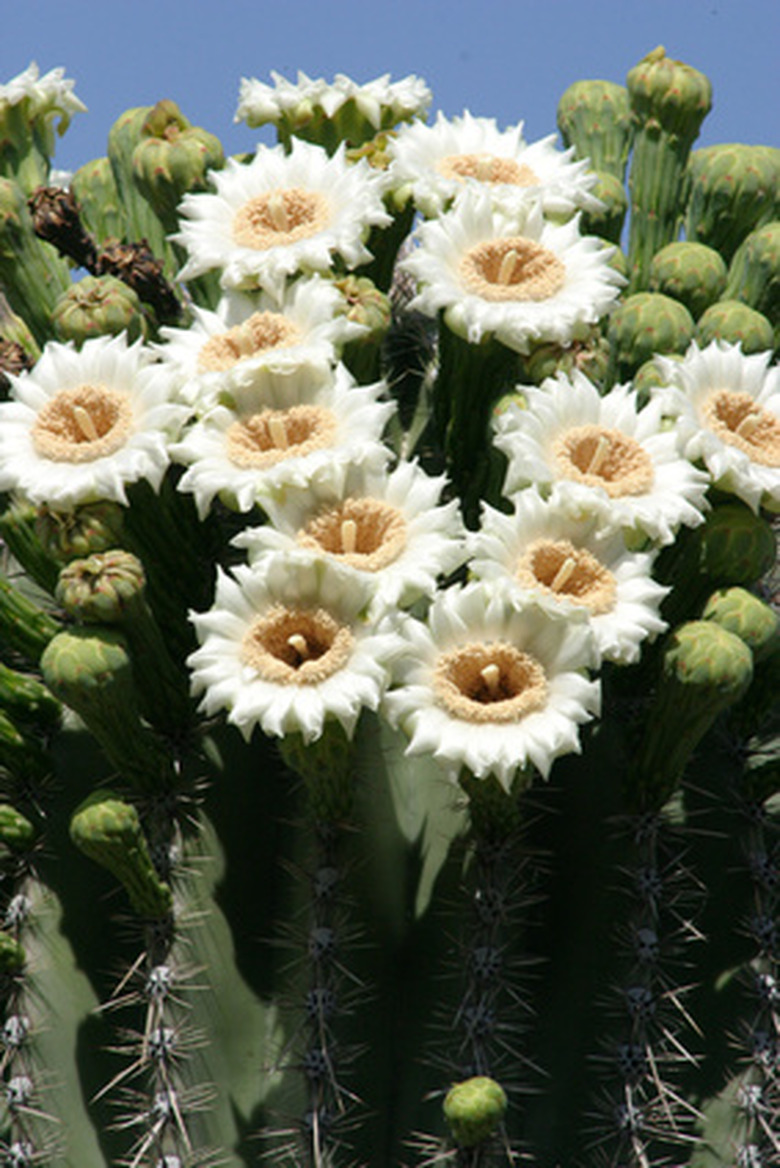What Kind Of Cactus Has Huge White Flowers?
The saguaro cactus, otherwise known as Carnegiea gigantea, is one of the most recognizable cacti around, particularly in the Sonoran Desert. It is also the largest cactus in North America. With tall columns and multiple arms that bend up, this cactus blooms large white flowers in the late spring season and juicy red fruit in the summer. Saguaros can grow large with up to 25 arms, and live as long as 150 to 200 years. An average old Saguaro has around five arms and is about 30 feet tall.
Range
The Saguaro cactus grows exclusively in the Sonoran Desert of southern Arizona, northwestern Mexico, and sporadically in southeastern California. It favors flats and slopes, especially when they are very rocky with cliffs.
- The saguaro cactus, otherwise known as Carnegiea gigantea, is one of the most recognizable cacti around, particularly in the Sonoran Desert.
Growth Form
The main column grows to 24 inches in diameter and is fluted, sometimes becoming smaller at the very base. The large arms curling upwards are what makes the cactus so recognizable in the desert. The flesh is smooth, waxy and spongy, and the spines grow about two inches long. A defining characteristic of the Saguaro is the way it absorbs water, expanding like an accordion. It can increase its weight by a ton.
When young, the Saguaro grows under a "nurse" tree or shrub for protection, and then proceeds to grow extremely slowly, sometimes not even a full inch in one year. The very shallow root system is supported by one main tap root that is about three feet long. From this root, more shallow roots span out that don't usually go deeper than one foot, while other small radial roots grow out almost to the distance of the saguaro's height. The roots anchor onto rocks and other larger roots for added anchorage.
- The main column grows to 24 inches in diameter and is fluted, sometimes becoming smaller at the very base.
- From this root, more shallow roots span out that don't usually go deeper than one foot, while other small radial roots grow out almost to the distance of the saguaro's height.
Blooming and Flowers
The Saguaro produces large, creamy white flowers from May to June that grow about three inches in diameter, outward from a four-inch-long tube. The flowers open at night when it is cooler and close during the hottest part of the day. A cluster of yellow stamens grow in a circular pattern on top of the tube before the flowers pop up, producing a sweet nectar that attracts hummingbirds, bats, birds and insects, providing cross-pollination. The Saguaro has more stamens per flower than any other desert cactus.
The flowers on the Saguaro don't bloom all at once over the course of a month; they average about 200 blooms per night.
Habitat
Saguaros need proper water and climate. They can't grow too high up on a mountain, or cooler air or frost may kill it. The cactus thrives mainly during the rainy season and retains the moisture year-round. Saguaros can grow in high heat, but cannot tolerate frost.
- The Saguaro produces large, creamy white flowers from May to June that grow about three inches in diameter, outward from a four-inch-long tube.
- The Saguaro has more stamens per flower than any other desert cactus.
Uses
From shelter to cooking, the Saguaro cactus has a range of uses and benefits. The three-inch-long, oblong, green fruit that ripens just before the rainy season is savored by many desert animals. The inside is juicy, ruby-red and filled with pulp and seeds. Native Americans used this fruit and juice for cooking and medicinal purposes. The fruit has over 4,000 seeds. The structure of the Saguaro is also useful for construction purposes. The woody stems are flexible and durable, and can be used for fences, furniture, roofs or walls. Native Americans used the stems to make baskets as well. The flesh of the cactus can be eaten also, but it is difficult to prepare and usually requires dehydration.
- From shelter to cooking, the Saguaro cactus has a range of uses and benefits.
- The woody stems are flexible and durable, and can be used for fences, furniture, roofs or walls.
